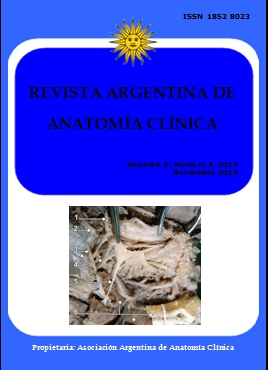DISSECTION AND DETAILED ANATOMY OF AN IMPACTED MANDIBULAR THIRD MOLAR. Disección y anatomía detallada de un tercer molar mandibular impactado
DOI:
https://doi.org/10.31051/1852.8023.v5.n3.14080Keywords:
impacted tooth, lingual nerve, mylohyoid nerve, submandibular ganglion, Diente impactado, nervio lingual, nervio milohioideo, ganglio de debajo de la mandíbulaAbstract
Los trastornos neurosensoriales del nervio alveolar inferior (IAN) o el nervio lingual (LN) se reportan comúnmente en casos del tercer molar inferior impactado. Los casos están documentados usualmente mediante estudios imagenológicos. Pruebas de disección de la anatomía detallada en estos casos son raras, sino inexistentes. Se informa aquí sobre un estudio de disección en un caso de un tercer molar inferior impactado (ángulo bucal), en un cadáver de un hombre adulto, 68 años de edad. Más allá de las “clásicas” relaciones del diente impactado con el IAN y el LN, también han sido encontradas estrechas relaciones con las ramas de LN, el ganglio de debajo de la mandíbula, el nervio milohioideo (MN) y la anastomosis del LN y MN. Estos detalles anatómicos deben considerarse también cuando tales casos están documentados en pacientes antes de procedimientos quirúrgicos. Los efectos de los daños del ganglio de debajo de la mandíbula deben ser analizados más.
Neurosensory disturbances of the inferior alveolar nerve (IAN), or the lingual nerve (LN), are commonly reported in cases of third mandibular molar impaction. Cases are usually documented by use of imagistic methods. Dissection proofs of the detailed anatomy in such cases are rare, if not absent. It is reported here a dissection study in a case of an impacted (bucco-angular) third mandibular molar, in an adult male cadaver, 68 years old. Beyond the “classical” relations of the impacted tooth with the IAN and the LN, close relations were also found with the LN branches, submandibular ganglion, mylohyoid nerve (MN), and the anastomosis of the LN and the MN. These anatomical details should be also considered when such cases are documented in patients before surgical procedures. Effects of the submandibular ganglion damage should be further explored.
References
Bataineh AB. 2001. Sensory nerve impairment following mandibular third molar surgery. J Oral Maxillofac Surg 59: 1012-17.
Chilla R, Nicklatsch J, Arglebe C. 1982. Late sequelae of iatrogenic damage to chorda tympani nerve. Acta Otolaryngol 94: 461-65.
Gomes AC, Vasconcelos BC, de Oliveira e Silva ED, da Silva LC. 2005. Lingual nerve damage after mandibular third molar surgery: a randomized clinical trial. J Oral Maxillofac Surg 63: 1443-46.
Grandini SA, Barros VM, Salata LA, Rosa AL, Soares UN. 1993. Complications in exodontia--accidental dislodgment to adjacent anatomical areas. Braz Dent J 3: 103-12.
Hashemipour MA, Tahmasbi-Arashlow M, Fahimi-Hanzaei F. 2013. Incidence of impacted mandibular and maxillary third molars: a radiographic study in a Southeast Iran population. Med Oral Patol Oral Cir Bucal 18: e140-15.
Janakiraman EN, Alexander M, Sanjay P. 2010. Prospective analysis of frequency and contributing factors of nerve injuries following third-molar surgery. J Craniofac Surg 21: 784-6.
Jerjes W, Upile T, Shah P, Nhembe F, Gudka D, Kafas P. 2010. Risk factors associated with injury to the inferior alveolar and lingual nerves following third molar surgery-revisited. Oral Surg Oral Med Oral Pathol Oral Radiol Endod 109: 335-45.
Lauesen SR, Andreasen JO, Gerds TA, Christensen SS, Borum M, Hillerup S. 2013. Association between third mandibular molar impaction and degree of root development in adolescents. Angle Orthod 83: 3-9.
Neves FS, de Almeida SM, Boscolo FN, Haiter-Neto F, Alves MC, Crusoe-Rebello I. 2012. Risk assessment of inferior alveolar neuro-vascular bundle by multidetector computed tomography in extractions of third molars. Surg Radiol Anat 34: 619-24.
Ortako?lu K, Okcu, K.M., Karasu, H.A., Günaydin, Y. 2002. Accidental Displacement of Impacted Third Molar into Lateral Pharyngeal Space. Turk J Med Sci 32: 431-33.
Potu BK, D'Silva SS, Thejodhar P, Jattanna NC. 2010. An unusual communication between the mylohyoid and lingual nerves in man: its significance in lingual nerve injury. Indian J Dent Res 21: 141-42.
Potu BK, Pulakunta T, Ray B, Rao MS, Bhat KM, D'Silva SS. 2009. Unusual communication between the lingual nerve and mylohyoid nerves in a South Indian male cadaver: its clinical significance. Rom J Morphol Embryol 50: 145-46.
Racz L, Maros T. 1981. The anatomic variants of the lingual nerve in human. Anat Anz 149: 64-71.
Rusu MC, Nimigean V, Podoleanu L, Ivascu RV, Niculescu MC. 2008. Details of the intralingual topography and morphology of the lingual nerve. Int J Oral Maxillofac Surg 37: 835-39.
Sivolella S, Boccuzzo G, Gasparini E, De Conti G, Berengo M. 2012. Assessing the need for computed tomography for lower-third-molar extraction: a survey among 322 dentists. Radiol Med 117: 112-24.
Smith WP. 2013. The relative risk of neuro-sensory deficit following removal of mandibular third molar teeth: the influence of radiography and surgical technique. Oral Surg Oral Med Oral Pathol Oral Radiol 115: 18-24.
Xu GZ, Yang C, Fan XD, Yu CQ, Cai XY, Wang Y. 2013. Anatomic relationship between impacted third mandibular molar and the mandibular canal as the risk factor of inferior alveolar nerve injury. Br J Oral Maxillofac Surg;10.1016/j.bjoms. 2013.01.011
Downloads
Published
Issue
Section
License
Authors retain copyright and grant the journal right of first publication with the work simultaneously licensed under a Creative Commons Attribution License that allows others to share the work with an acknowledgement of the work's authorship and initial publication in this journal. Use restricted to non commercial purposes.
Once the manuscript has been accepted for publications, authors will sign a Copyright Transfer Agreement to let the “Asociación Argentina de Anatomía Clínica” (Argentine Association of Clinical Anatomy) to edit, publish and disseminate the contribution.



